Genre: Sports Publisher: Sega of Japan Developer: Sega of Japan Players: 1-4 Released: 1993
Soccer is, after baseball, the second most favorite team sport in Japan. Nevertheless, until the early ’90s the soccer landscape was pretty divided. Until 1992 there existed the Japan Soccer League, an amalgamation of several amateur teams, mostly out of universities and schools, playing alongside a few works teams of big corporations like Panasonic or Nissan, which had small playing fields but no real stadiums. However, in the late ’80s and early ’90s, there was a big drive towards turning soccer more professional, in order to improve the quality of the overall players (and by extension, the national selection), draw a bigger audience, and thus make the creation of dedicated stadiums a more viable option. Thus, in 1992, the J. League was founded, a new top division separate from the old Japan Soccer League consisting of teams deemed viable to last in a high-quality sports environment, a bit similar to the way the British Premier League is handled nowadays. On May 15, 1993, the league started its first season with a match between Verdy Kawasaki and the Yokohama Marinos. As an interesting tidbit, one of the inaugural teams, Shimizu S-Pulse, was specifically created for that purpose in order to represent a prefecture (Shizuoka) rather than a company in that league.
What better occasion is there to create an official soccer game tying into the start of the first professional top division in Japanese soccer? Well, Sega apparently felt the same. On June 18, J. League Pro Striker (occasionally called J. League Pro Striker ‘93 after its title screen) was released for the Mega Drive as the league’s official soccer simulation, or “TV Game” as the box proclaims, for up to four players. In December 1993, a slightly tweaked revision named J. League Pro Striker Perfect, which is commonly also known as J. League Pro Striker Kazenban, was released in a bundle also containing a Sega Multi-Tap. Basically though, the two are the same game, offering up the entire roster of the J. League’s inaugural season for the keen soccer fan. That’s right: A whopping 10(!) teams await!
Like the previous paragraph suggests, the game is exclusively focused on the Japanese soccer division and completely tailored towards Japanese fans. This isn’t just reflected by the comparatively small number of teams for a soccer video game, or the fact that all screen texts are only in Japanese, but also by the rule set: In the 1993 season of J. League there were no draws. When two teams were at an equal score after 90 minutes, the game went into sudden-death overtime. When no victor emerged after two 15-minute halves, a decision was reached in a penalty shootout, even during the regular season. There was no real points system in place during that first season either, and only wins or losses were counted. (This was later amended several times until in 2003 extra time was abolished, and the international 3-1-0 points system was introduced, but this of course isn’t in the game). Looking at things this way, it makes sense that it was never brought to other regions, not even into the otherwise soccer-crazy PAL areas.
This already gives the game a somewhat lightweight feel. On top of that, however, the teams or players don’t have any visible stats, nor does it feel like any secret ones are in place. Since it was the league’s first season, it had apparently been difficult to properly gauge individual skill or overall strength levels. So, playing as the Yokohama Flügels doesn’t really feel much different than having chosen the Kashima Antlers, other than the teams having different jerseys and player names (which are all in Japanese, so if you don’t know how to read Kanji, this doesn’t matter anyway). It is strange for an early ’90s soccer game to only present such a small selection with hardly any differences in look and feel to them. The “perfect” edition also allows a special exhibition match between a west and an east all-star selection, which was probably taken from a MVP list after the first half-season was due in real life. In the regular edition, that spot is instead filled by playing with one of the league teams against a “Sega Stars” selection. As already hinted at, the difference doesn’t really matter, since every team pretty much feels the same anyway. Other game modes are tournament (itself split into either a best-of-four or a best-of-eight style tournament) and, of course, playing a full season, where the progress can be saved via memory backup. The Perfect edition even remembers the stats of a previous season for later playthroughs. Nice but only interesting for fans who like to keep track of their statistics.
So, what about the game itself? Since every team pretty much feels the same, you may simply choose the name that most appeals to you and stick with that one. The team names are interesting enough for that purpose – if I didn’t know those were official ones, they would appear to be made up for western audiences, but they’re definitely real alright. Once you start the game, you can choose your intended formation, which can be switched around after each half-time break. Once that is confirmed, you are ready to enter the pitch.
The game uses a (slightly slanted) top-down view of the vertically aligned field. A radar shows the placement of all players. On the offense, A shoots the ball while B is assigned to a long and C to a short pass. On the defense, A results in a sliding tackle (which, if it connects with an opposing player, usually results in the referee calling a foul), while C switches control to the player that is supposedly nearest to the ball. This feels extremely odd, to say the least, because you have to manually switch out control every single. Whereas in other soccer games you usually can guide the nearest player automatically, here you have to press the button every single time, no matter if you were passing the ball along or want to take control of the goalie. The way this is implemented feels rather weird. Often, I was passing the ball and kept forgetting that if the ball didn’t land exactly at the intended player, I had to make the switch myself. If the nearest player wasn’t on screen, switching out can result in a crapshoot whether you can call up a team member who’s in front or behind the opposing striker. And if you want to change players but end up taking charge of the goalie by accident, this can have fatal results. Other than that, the controls feel rather loose and, at times, rather inaccurate: More than once button presses are ignored and intended shots or passes weren’t performed.
Finally, the way shots are handled is rather weird as well. Personally, I felt that scoring a goal is easier if you utilize the long pass rather than the intended shoot button for the final shot, since the goalie has a harder time properly blocking that one and it gains a farther reach without having to press the button down for as long. The regular ’93 edition, as well as the Perfect revision, play virtually identical, although the speed has been slightly increased for the latter, which results in a minimally better game flow. The differences are marginal at best, however, so the games rate pretty much the same.
As for the audio, the music during the menu screens is decent, and the voice samples are without scratches, though they sound murky, though that might be because they only consist of small Japanese samples spoken very fast, which are unintelligible to my ears at any rate. The sound effects during the game are an entirely different matter, however. The ambient stadium atmosphere consists mostly out of a loud air horn style honking, kind of reminiscent of those god-awful vuvuzuelas during the 2010 World Cup in South Africa. This Mega Drive rendition sounds pretty much like someone leaning on a car horn for the entirety of the match. Needless to say, it gets very annoying very fast, and I didn’t manage more than two short three-minute games in a row before shutting of the sound entirely in order to prevent my ears from bleeding.
So how does the game rate overall? Well, it isn’t really bad per say. It flows nicely, the controls are a bit loose but mostly decent, and the sound is a mixed bag. The graphics are acceptable and pretty much on par for a ’93 release. Having only 10 teams without any real discernible differences between one another is already a huge letdown. Couple that with a few weird control issues and some incredibly irritating sound effects, and the game drops completely out of the recommendable category down to barely mediocre. At least it’s slightly better than some of the other Mega Drive Soccer games that came before, though that’s not saying much. If that game reflects the quality of Japanese Soccer during the era it was created in, it’s no wonder the Japanese selection didn’t qualify for the World Cup until 1998.
SCORE: 5 out of 10

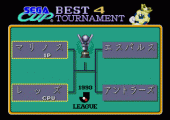
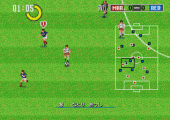
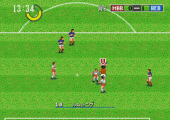
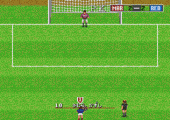
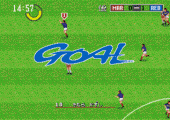
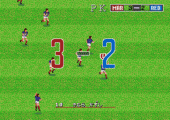
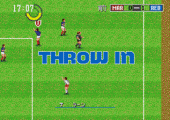
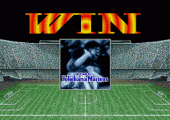
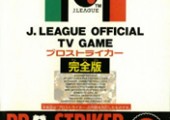
Recent Comments